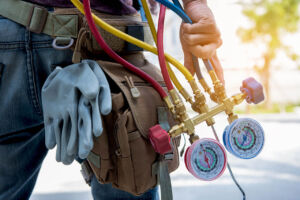The nursing field offers two entry-level career paths, each with its own rewards. Some nurses train to be vocational nurses, others take their first steps forward as Certified Nursing Assistants (CNAs). If you’re ready for a rewarding career in a thriving industry, all that’s left to decide is which road to take. Here’s the map.
What Does an LVN Do?
Licensed vocational nurses, known in some states as licensed practical nurses, provide direct patient care in private homes and healthcare facilities. As entry-level nursing professionals, they play a key role within the healthcare system.
Their job responsibilities are defined by the state in which they work, so they vary nationwide. But the work typically includes:
Patient Care
LVNs are tasked with providing basic nursing care to patients of all ages. Under the supervision of a registered nurse or licensed medical provider, they assist people with activities of daily living, such as bathing, dressing, eating and toileting. Vocational nurses also provide safety supervision, keeping patients safe by adapting their environments to offset physical or cognitive challenges.
Medication Administration
Vocational nurses administer medications to patients, including oral, topical, and injectable drugs. They ensure that medications are given safely and accurately while monitoring patients for therapeutic effects and adverse reactions on their doctor’s behalf.
Patient Monitoring
LVNs monitor patients for changes in their condition, notifying their supervisor or the patient’s doctor when concerns arise. They take regular vital signs and screen patients for pain, intervening when necessary. As frontline caregivers, they spend a lot of one-on-one time with patients, managing their physical, emotional, and psychological needs.
Performing Procedures
Vocational nurses perform or assist with a broad range of medical procedures. Under a doctor’s order, they may dress wounds, insert urinary catheters, clean tracheotomies, remove sutures, flush feeding tubes, check blood sugar, perform end-of-life care and collect biological specimens for laboratory testing.
Vocational nurses are also trained in basic lifesaving techniques, including oxygen administration and CPR.
Team Collaboration
As members of the healthcare team, LVNs work with healthcare professionals, from doctors to therapists. They communicate critical information, contribute to the development of care plans, and ensure the continuity of care. As the caregiver who is often closest to the patient, they help keep everyone on the same page.
Recordkeeping
Continuity of care depends on accurate recordkeeping, so LVNs document the care they provide during each shift, from the patient’s vital signs to complaints of physical symptoms.
Companionship and Emotional Support
In healthcare settings like nursing homes, most patients interact more with nurses than their families. And for some people, a nurse’s hand is the only one they have to hold. LVNs provide emotional support to patients and their families, offering reassurance and companionship during challenging times.
Patient Education
LVNs provide instructions to patients and their families on timely topics, including medication administration, disease management, and home safety. They save lives by empowering people to help themselves.
What Does a CNA Do?
Certified nurse’s assistants perform or assist with patient care under the direction of a licensed nurse. Specific responsibilities may vary based on the healthcare setting and state regulations.
An LVN can delegate many tasks to a CNA within their scope of practice and competency.
A few examples include:
Providing Personal Care
CNAs help patients with activities of daily living with a nurse’s guidance. Tasks may include serving meal trays, measuring intake and output, and cleaning dentures. They also help immobile patients transfer from back to side or from bed to chair to maintain their circulation and prevent bedsores.
Taking Vital Signs
CNAs may obtain and record vital signs on an LVN’s behalf, reporting abnormal results for follow-up.
Supportive Care
Nursing assistants provide emotional support and therapeutic recreation activities for patients, allowing them to participate more fully in life by being a safety net. In a nursing home, for example, they help patients manage their belongings and supervise them on day trips.
Assisting with Medical Procedures
CNAs assist nurses during medical procedures by preparing equipment, gathering supplies, obtaining specimens, and monitoring patient comfort.
What Is the Difference Between an LVN and a CNA?
There are several key differences between an LVN and a CNA, including:
Training
CNAs complete a short training program lasting 4-16 weeks, on average. Instruction includes clinical experience. They become certified after passing a competency exam.
Vocational nursing students undergo more rigorous training, spending about a year in school. Programs cover both nursing theory and practical skills.
Graduates must also pass the licensure exam before being fully credentialed. And some states require continuing education to renew licenses.
Scope of Practice
CNAs have a limited scope of practice. As paraprofessional caregivers, they’re trained to perform bedside care under direct supervision, following an established plan of care.
LVNs have a broader scope of practice and can perform many of the same clinical tasks as registered nurses. Fully licensed, they have more autonomy to make independent nursing decisions.
Supervision
CNAs are supervised by licensed nurses or physicians.
LVNs are supervised by registered nurses or licensed healthcare providers. They, in turn, supervise nursing assistants and other unlicensed medical staff. LVNs are responsible for the outcome of all tasks they choose to delegate to nursing assistants.
Career Opportunities
CNAs can climb the career ladder by becoming certified medication assistants. But to become nurses, they must enroll in an entry-level nursing program.
LVNs can further their careers without more training by becoming charge nurses and supervisors. But to become a registered nurse, they must complete an LVN-to-RN bridge program. LVNs can further their careers faster and in more settings because they have more training and professional licenses.
How Do You Become an LVN?
If you have a high school diploma or general equivalency certificate, the next step to becoming an LVN is to enroll in a lifestyle-friendly vocational school program. Full-time students graduate in about a year, well-prepared to take the licensing exam.
The curriculum is a fusion of classroom hours and clinical instruction, including rotations in real-world healthcare settings. Supervised clinical training in medical facilities provides the hands-on experience new nurses need.
Upon graduation, you’ll apply for a license through Texas Nursing Board. Each state has its own process and academic requirements for licensure, so it’s important to familiarize yourself with the specifics in the state you live in.
Once approved, you’ll sit for the National Council Licensure Examination for Practical Nurses (NCLEX-PN) — a passing grade earns you a license. Some states permit graduate nurses to work for a limited time while they wait for a test date. It’s an excellent opportunity to gain valuable experience.
Final Thoughts
All nurses start their careers somewhere. How you do it is less important than getting started. If you’ve dreamed of becoming a vocational nurse, a vocational school program can prepare you for success.
Licensed Vocational Nurse
Classes for the Vocational Nursing program are conducted in a student-friendly atmosphere conveniently located in Austin, Texas. After graduating from the Licensed Vocational Nursing program, students can apply to take the National Council Licensure Examination for Practical Nurses (NCLEX-PN), become a Licensed Vocational Nurse (LVN), and start their exciting new career immediately.
Contact us today to learn more about our CyberTex Austin campus.





